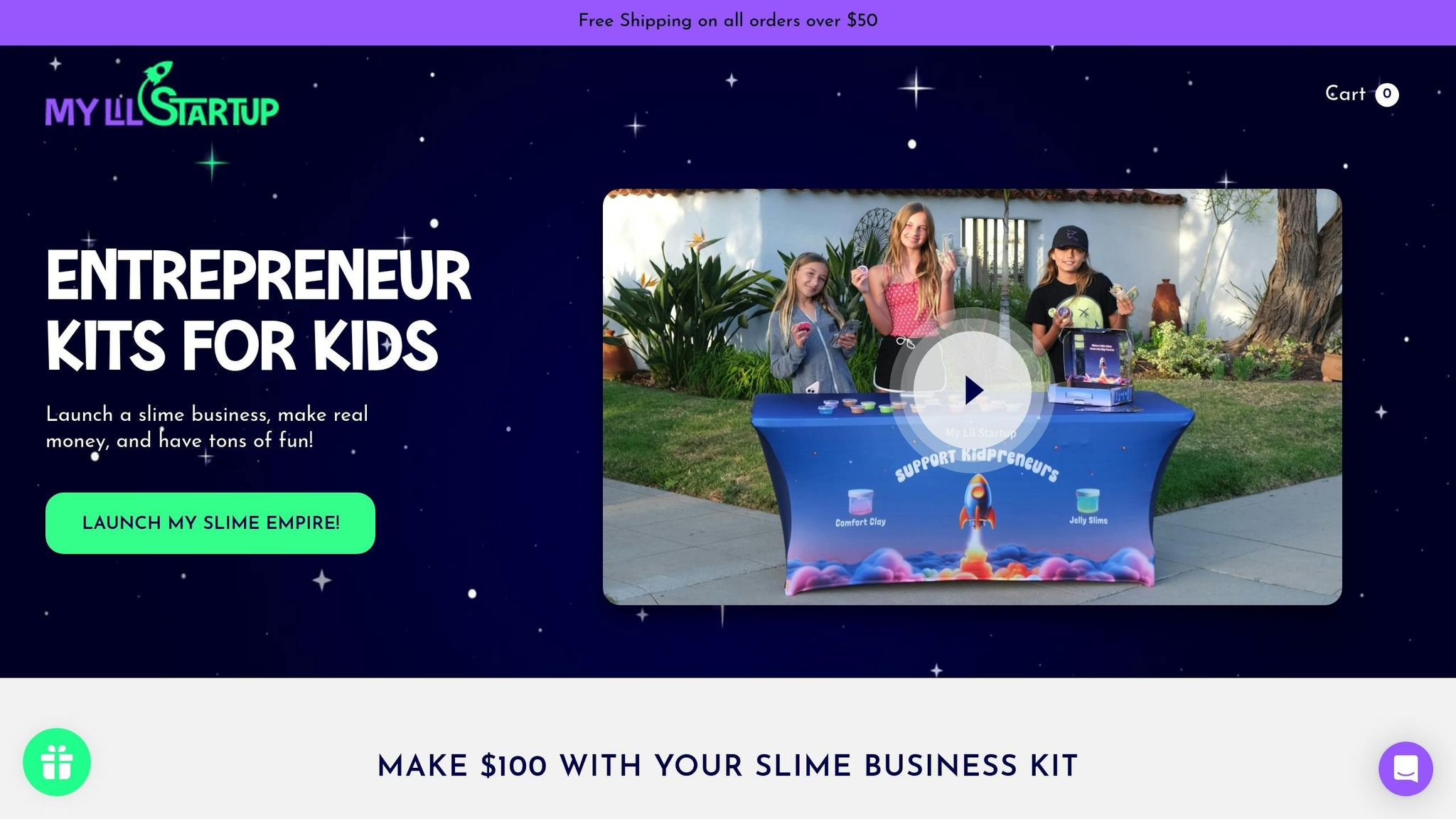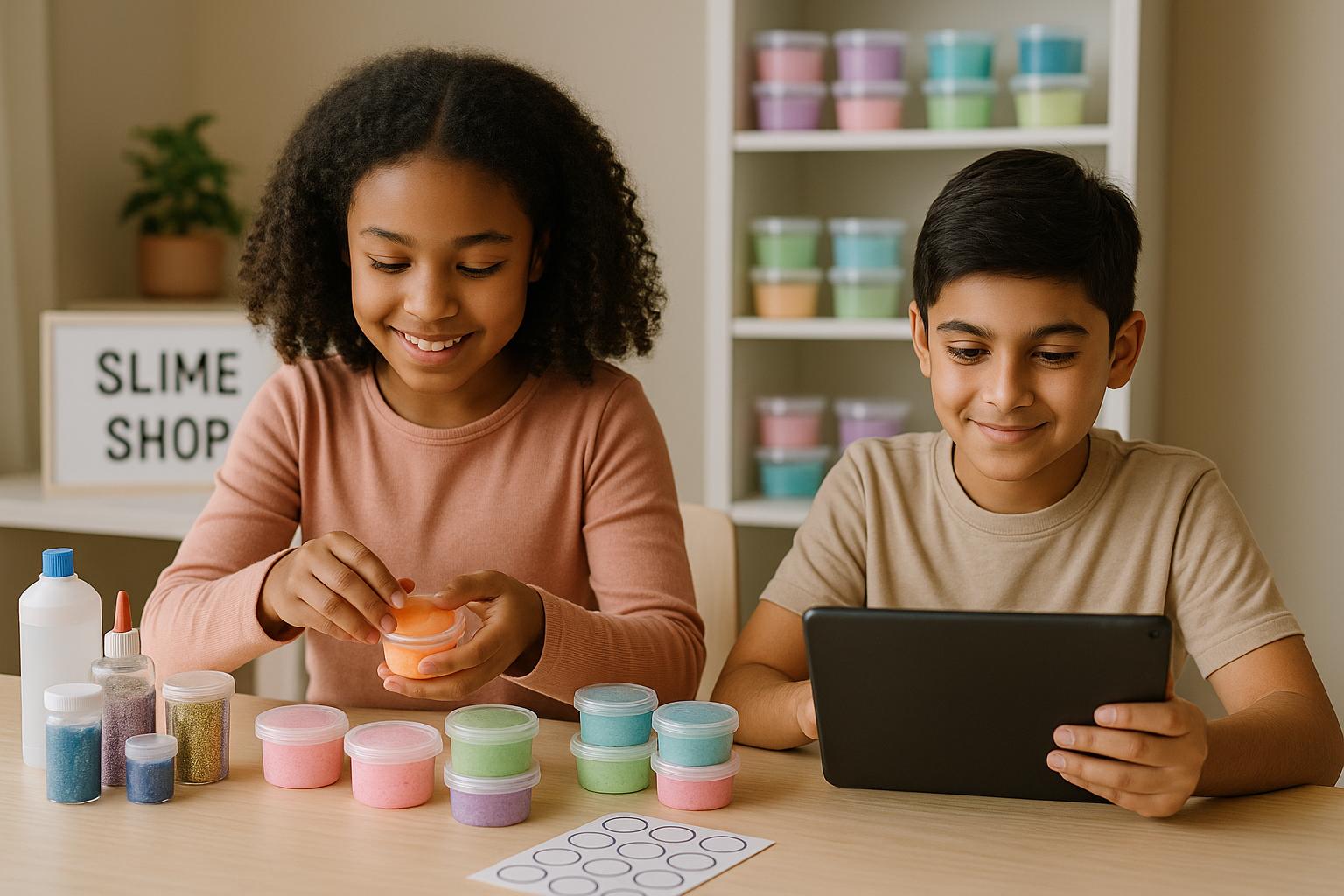Starting a slime business from home can earn you up to $100 per hour while teaching valuable entrepreneurial skills. Whether you're a kid or a parent helping out, this guide walks you through everything you need to know - from setting up your workspace to pricing your products and growing your business.
Here’s the quick breakdown:
- Costs to start are low: Basic supplies like glue and activators cost just $2 per batch.
- Profit margins range from 20-40%: Sell slime for $1–$4 per ounce, depending on customization.
- Simple setup: Use your kitchen table with minimal supplies like bowls, glue, and containers.
- Marketing is key: Sell at local fairs, online, or school events. Social media can boost visibility.
- Growth potential: Reinvest profits in bulk supplies or kits like the $99.95 Mogul Bundle to scale up.
With the right tools and strategies, you can turn a fun hobby into a thriving business. Let’s dive into the details.
How to Start a Slime Shop! EVERYTHING You Need to Know
Step 1: Set Up Your Slime Making Space
Turn your kitchen table into the ultimate slime-making zone. Start by clearing off a flat surface near a sink, then cover it with a plastic tablecloth or parchment paper to keep things clean and organized.
Tools and Supplies You'll Need
Starting a slime business means having the right tools and ingredients on hand. For the base, use PVA washable school glue - white glue works great for soft, stretchy slime, while clear glue gives a glossy, shiny finish.
Next, pick an activator to bring your slime to life. Options include:
- Borax solution: Mix 1 teaspoon of borax with 1 cup of warm water.
- Saline solution: Look for one with boric acid and sodium borate.
- Liquid starch: Another easy-to-use option for activating slime.
You'll also need basic tools like mixing bowls, measuring spoons and cups, a spatula, and airtight containers for storage. Disposable gloves can come in handy, too, especially for messier batches.
To make your slime unique, add fun extras like food coloring, glitter, foam beads, fake snow, or soft clay. For even more options, check out DIY Craft Warehouse - they offer everything from glue and glitter to colorants, clay, scents, and containers to help you customize your creations.
Safety First
Stick to non-toxic, child-safe ingredients, and always read product labels carefully. If you're using borax, remember to dissolve 1 teaspoon in 1 cup of warm water as directed. Once your slime is ready, store it in airtight containers to keep it fresh and stretchy.
If gathering supplies and setting up feels like too much work, there's a simpler way to get started.
My Lil Startup Slime Kit: A Ready-Made Solution

The My Lil Startup Slime Business Kit takes the hassle out of preparation by giving you everything you need in one package. Here’s what they offer:
- Starter Kit ($39.95): Includes 20 pre-made slimes, plus glitter, charms, beads, and glow powder for customization. You’ll also get step-by-step instructions, sales tips, marketing flyers, and thank you cards to help you hit the ground running.
- Growth Bundle ($59.95): Everything in the Starter Kit, plus a professional tablecloth for a polished sales setup.
- Mogul Bundle ($99.95): Adds refill supplies for 40 more slimes, boosting your earning potential even further.
This kit was created by a father-daughter duo with a knack for startups. After Chloe’s lemonade stand didn’t pan out, they pivoted to slime, and she earned over $100 in just an hour. With Jon’s experience founding seven companies and 11-year-old Chloe’s kid-friendly insights, this kit is thoughtfully designed to help kids succeed.
Instead of spending weeks hunting down supplies and experimenting with recipes, this all-in-one kit lets you start selling slime right away.
Step 2: Make Quality Slime That Sells
Creating slime that strikes the right balance between stretchiness and texture is the key to making a product that stands out.
Simple Slime Recipes
Start with a reliable, basic recipe. Combine 4 fl oz of white PVA glue with ½ tsp of baking soda. Slowly add 1 tbsp of saline solution containing boric acid and sodium borate. Stir until the mixture starts pulling away from the bowl, then knead it for 2–3 minutes. That’s it - your slime will be ready in under 5 minutes.
"Best recipe ever!!!! 5 Stars!!!" – Robin Haber
Want a glossy look? Swap the white PVA glue for clear glue.
If your slime ends up too thick, soften it by adding a few drops of lotion. On the flip side, if it’s too runny, mix in a bit more glue until the texture feels just right. Keep track of any tweaks you make so you can recreate your best batches with ease.
"Very easy. Best one we tried!" – Kim
Add Special Ingredients for Custom Slime
Once you’ve nailed the basic recipe, it’s time to get creative. Customized slime can draw higher prices because people love unique options. Take Luxury Slimes LLC as an example: in January 2025, they sold an 8oz custom slime for $13.99, offering customers the chance to pick features like color and scent. One happy customer, Luis Teruel, ordered a blue, thick, and glossy snow fizz slime with a black cherry scent and vintage-style add-ins - and he couldn’t have been more pleased with the result.
To experiment with textures, try adding shaving cream for a fluffy finish or extra clear glue for a buttery texture. These small changes can justify charging an extra $2–4 per container.
Color and scent also make your slime memorable. Add a few drops of food coloring for vibrant shades, and enhance the sensory experience with essential oils like vanilla, strawberry, or lavender. In February 2025, Aleisha made a themed “monster slime” using green food coloring, chunky green glitter, and mini googly eyes, proving how simple add-ins can make your slime stand out.
For a touch of sparkle, mix in fine glitter or create texture contrasts with foam beads, mini charms, or plastic confetti. Packaging these creations in clear containers allows customers to see the fun details before they buy.
Even with custom recipes, you might need to adjust the formula occasionally to ensure it’s just right.
Fix Common Slime Problems
If your slime feels too sticky, gradually add saline solution while kneading. If it’s stiff, work in a drop of warm water or a small amount of lotion. For slime that lacks stretch, knead it for 3–5 minutes and, if necessary, add a little more glue.
To keep your slime fresh, store it in airtight containers labeled with the creation date and ingredients. Always test each batch to ensure it stretches and bounces perfectly.
Step 3: Price Your Slime and Handle Business Basics
Once your slime products are perfected, it's time to focus on managing costs and handling the essentials of running a business. Setting the right price and keeping your finances in order will help you hit that $100/hour target while staying on top of legal requirements.
Figure Out Costs and Set Prices
Start by calculating how much it costs to make a batch of slime. Since raw materials make up about 30–40% of your expenses, keeping a close eye on these costs is key.
Here’s a breakdown of typical monthly expenses:
| Raw Material | Monthly Cost ($) | Percentage of Total Cost |
|---|---|---|
| Glue | 200 | 40% |
| Boric Acid & Baking Soda | 75 | 15% |
| Colorants & Additives | 50 | 10% |
| Texturing Agents | 50 | 10% |
| Containers | 50 | 10% |
| Tools & Equipment | 75 | 15% |
For each batch, basic ingredients like glue, activators, and baking soda cost between $0.10 and $0.50. Additives, such as glitter or scents, can tack on an extra $0.05 to $0.20 per batch. Don’t forget to include packaging costs, as these can quickly eat into your profits.
Once you know your costs, research the market. On average, slime sells for about $1 per ounce, but custom designs or unique varieties can fetch higher prices. Check local craft fairs or online platforms to see what others are charging in your area.
To determine your price, add up the total cost of ingredients, packaging, and any shipping fees (if you’re selling online), then divide that by the number of units in the batch. Also, consider buying supplies in bulk. This can cut your costs by up to 15%, helping you maximize your profit margins.
With your pricing nailed down, it’s time to focus on tracking your finances to keep everything running smoothly.
Keep Track of Money In and Out
Recording every dollar spent and earned is crucial - not just for staying organized but also for tax season.
Set up a simple system to track your daily sales. For each transaction, note the date, product sold, quantity, and total amount received. Similarly, document every expense, from ingredients to packaging and tools. Keep all receipts in one place, whether that’s a folder or an envelope.
Use sales trackers to monitor your progress toward the $100/hour goal. Tracking your transactions can also reveal which products are your best sellers and which days bring in the most revenue.
It’s a good idea to put aside a portion of your earnings for future supply purchases. Regularly reviewing your costs will help you spot areas where you can save money, ensuring your pricing stays competitive even if ingredient prices fluctuate.
Business Rules and Permits
Even if you’re running your slime business from home, you’ll need to follow local rules regarding licensing, zoning, and taxes. Start by checking with your city or county clerk’s office to find out what permits, fees, and restrictions apply.
In most cases, you’ll need a general business license from your city or county. If you’re working from home, a home occupation permit may also be required to confirm that your business complies with local zoning laws.
Since you’re selling a physical product, a sales tax license might be necessary. Skipping this step could lead to legal trouble in some areas. Additionally, check with your state’s environmental protection agency or local health department to see if you need a health inspection or permit. While slime isn’t a food product, some regions have specific regulations for items that children handle or come into contact with.
Taking care of these administrative details not only protects your business but also reassures parents and customers. Plus, it helps establish a professional image, which can support higher prices for your custom slime creations.
sbb-itb-a46f019
Step 4: Market and Sell Your Slime
With the groundwork for your business in place, it's time to focus on attracting customers and increasing sales. Here are some practical tips to help you promote your slime and grow your business.
How Kids Can Advertise Their Slime
Word of mouth is your secret weapon. Start by sharing your business with friends, family, neighbors, and classmates. Happy customers can help spread the word, so encourage them to tell others about your slime.
Get creative with flyers and business cards using your My Lil Startup kit. Use bright colors, pictures of your best slime creations, and include your contact information and prices. Hand these out at local events or to neighbors to grab attention.
Social media platforms like Instagram and YouTube are fantastic for showing off your slime. With your parents' guidance, post videos and photos of the slime-making process, different textures, and happy customers enjoying their purchases. This can help you reach a much larger audience.
Don't forget school events! Many schools allow students to sell homemade items during entrepreneurship weeks or special fairs. Ask your teachers or principal if you can set up a booth at school events to showcase your creations.
Once you've let people know about your business, it’s time to decide where to sell your slime.
Best Places to Sell Slime
Local markets and craft fairs are perfect for selling handmade slime. Children's business fairs are especially great because they’re designed for young entrepreneurs like you. These events let you talk directly with customers, show off your products, and build relationships that can lead to repeat sales.
Online platforms like Etsy, eBay, Instagram, Facebook, or even your own website can help you reach a wider audience. When selling online, make sure your listings include clear photos, descriptions of textures, ingredient lists, and details about available colors and quantities.
School events can also be a fantastic place to sell slime. If your school allows it, you can stand out by offering unique varieties at competitive prices. Fundraisers, talent shows, and sports events are all great opportunities to set up a small booth and sell your creations.
Neighborhood stands are another great option, especially if you live in an area with lots of foot traffic. Set up a table in your front yard during busy times like weekend mornings or after school. Just make sure you have your parents' permission and supervision.
By combining these selling options, you can create a steady flow of customers for your slime business.
Create an Attractive Sales Setup
A neat and eye-catching display can turn curious browsers into paying customers. Use the tablecloth from your My Lil Startup Growth Bundle to create a clean and inviting setup that highlights your products.
Organize your slime by type, color, or price. Keep everything clean and clearly labeled, and place your most colorful or unique creations front and center. This will grab attention and encourage people to take a closer look.
Keep track of your sales using a notebook or app. This helps you see which products are selling well and how much money you’re making per hour.
Offer small samples so customers can feel the texture and quality of your slime without contaminating the rest of your inventory. This hands-on experience can help close the sale.
If you have any permits or licenses, display them to show that your business is legitimate. Use the marketing materials from your My Lil Startup kit to further demonstrate your professionalism.
Make sure prices are clearly marked with signs or labels so customers know exactly how much each item costs. You can also offer special deals, like bundles or discounts for buying multiple items, to encourage larger purchases and move inventory more quickly.
With these strategies, you're set to grow your slime business and keep those sales rolling in!
Step 5: Grow Your Slime Business Bigger
Now that you’ve got the basics of sales and operations down, it’s time to focus on scaling your slime business. A good rule of thumb is to reinvest 20–30% of your earnings to ramp up production and improve your profit margins.
Use Profits to Buy More Supplies
Reinvesting in bulk supplies like glue, activators, and decorative items can save you a significant amount of money - anywhere from $500 to $2,000 annually on material costs. Plus, buying in bulk helps you track which slime varieties are most popular, so you can focus on what sells best.
For instance, you might want to consider the My Lil Startup Slime Business Refill Kit, which costs $59.95. This kit includes enough materials to make 40 additional slimes, giving you a straightforward way to reinvest your profits and expand your production capacity.
Once your inventory is stocked up, you’ll be in a great position to introduce new products and diversify your offerings.
Add New Products to Your Business
With your supply inventory growing, it’s the perfect time to explore new product ideas and revenue streams. Holiday-themed slime bundles are a great way to tap into seasonal demand. For example, you could create Halloween slimes in spooky colors or Valentine’s Day sets with festive add-ins. Many slime businesses see a 20–30% bump in sales during peak holiday seasons.
Another option is offering custom slime kits where customers can choose their favorite colors, scents, and decorations. These customized kits often have profit margins of 30–35%, compared to 20–25% for standard DIY kits. If you’re looking for more ways to grow, consider hosting slime-making workshops. Community workshops can yield profit margins of 20–40% for mobile setups and 10–30% for studio-based ones. You could also add branded merchandise like stickers, containers, or t-shirts to boost income while increasing your brand’s visibility.
Compare My Lil Startup Bundle Options
As you expand, choosing the right bundle for your growth strategy is key. Here’s a quick comparison of the available options:
| Bundle | Price | What's Included | Potential Earnings | Best For |
|---|---|---|---|---|
| Starter Kit | $39.95 | 20 pre-made slimes, glitter, charms, beads, glow powder, instruction book, sales tips, flyers, cards | $100 | New entrepreneurs testing the market |
| Growth Bundle | $59.95 | Everything in Starter Kit + tablecloth for a professional setup | $100 | Established sellers enhancing presentation |
| Mogul Bundle | $99.95 | Everything in Growth Bundle + refill kit for 40 additional slimes | $300 | Entrepreneurs scaling up production |
The Mogul Bundle is particularly useful for those looking to scale up. It increases your production capacity significantly, providing materials to make a total of 60 slimes and potentially boosting profits by $200 compared to the Starter Kit. On the other hand, the Growth Bundle includes a tablecloth, which helps create a more polished and professional display - perfect for attracting customers at fairs and markets.
For those ready to take their business to the next level, the refill kit alone costs $59.95 if purchased separately. Opting for a bundle not only saves money but also gives you the tools to scale more efficiently. Many slime entrepreneurs report profit margins between 20–40%, with annual earnings ranging from $30,000 to $75,000. Investing in the right bundle could put you on the fast track to achieving these numbers while setting your business up for long-term success.
Conclusion: Build Skills and Confidence Through Business
Starting a slime business right from your kitchen table can do more than just generate income - it builds confidence, sharpens resourcefulness, and strengthens money management skills. These are lessons that stick with kids far beyond the world of slime, helping them develop the entrepreneurial mindset needed for future success.
The slime market is thriving, growing at an impressive 20% annually, with a current valuation of $2.5 billion. It’s projected to expand by another 10% each year. This steady growth makes it an ideal time for young entrepreneurs to dive in and start honing their skills early.
To make the process easier, My Lil Startup kits provide everything kids need to jumpstart their slime business. These kits eliminate the hassle of setup and logistics, allowing young creators to focus on key business lessons.
"Everything they need to make and sell their favorite sensory experience is included in this kit. This is a brilliant way to teach kids how to be entrepreneurs this summer." - Stephanie Felzenberg, Growth Bundle Customer
Through these kits, kids learn to manage inventory, engage with customers, handle money, and reinvest profits to grow their businesses. These hands-on experiences build a strong foundation for tackling future ventures and instill confidence in their ability to solve problems and create value.
"I was blown away by the My Lil Startup Entrepreneur Kit! They thought of everything to make it a fun, easy and seamless experience for kids and parents. My kids learned so much using this kit!! The guidebooks were engaging and practical. I highly recommend My Lil Startup for any aspiring kid entrepreneurs!!" - Melissa, Growth Bundle Customer
Whether choosing the $39.95 Starter Kit or going big with the $99.95 Mogul Bundle, young entrepreneurs gain practical insights into running a business. From setting up their workspace to reinvesting profits, every step helps them grow into capable, confident business leaders.
This isn’t just about earning $100 an hour selling slime - it’s about shaping a mindset. It’s about teaching kids the skills and confidence they need to take on bigger challenges and succeed as they grow.
FAQs
What legal steps do I need to take to start a slime business from home in the US?
Starting a slime business from home in the US means following key safety and legal rules. Your slime products must comply with federal safety standards, which include testing for harmful substances like lead and phthalates. Additionally, you’ll need to adhere to the Consumer Product Safety Improvement Act (CPSIA), which requires proper labeling and safety certifications.
Although you might not always need specific permits or licenses to sell slime, staying compliant with these regulations is essential for running a legitimate and reliable business. Be sure to have your products tested in approved labs, label everything correctly, and keep up-to-date with any changes to safety guidelines.
What are the best ways to market my slime products and grow my business beyond local events?
To take your slime business beyond local events, it's time to focus on building a strong online presence and connecting with your audience. Platforms like Instagram, TikTok, and Facebook are perfect for showcasing your products. Share fun videos, tutorials, and vibrant photos that highlight your slime’s unique features. Developing a consistent brand style and using trending hashtags can help your posts reach a broader audience.
You can also expand your reach by selling on platforms like Etsy or even launching your own website. These options let you connect with customers across the country. Collaborating with local influencers or running giveaways are great ways to boost your brand visibility. Plus, encouraging satisfied customers to share their purchases on social media and leave reviews can create a ripple effect - word-of-mouth can be incredibly impactful.
For offline growth, consider hosting slime-making workshops to engage with your community or partnering with nearby businesses to cross-promote products. By blending creative online strategies with local outreach, you'll be able to connect with more people and take your business to the next level.
How can I manage my slime business finances and boost profits?
To keep your slime business finances in check and make the most of your profits, start by tracking every dollar you spend and earn. A simple spreadsheet or a budgeting app can do wonders for monitoring costs and spotting opportunities to cut expenses. One smart move? Buy your materials in bulk - this can bring down costs considerably. Also, refining your production process can help you work more efficiently, saving both time and money.
Want to increase your profits? Offer a variety of slime options, like themed or seasonal slimes, to draw in a wider customer base. When setting prices, factor in your material costs, production time, and what the market is willing to pay. Be sure to revisit your pricing strategy regularly to ensure you're hitting a solid profit margin - this can range anywhere from 20% to 70%, depending on how efficient you are and how much you sell. By staying organized and fine-tuning your approach, your slime business can become a thriving, money-making venture!




